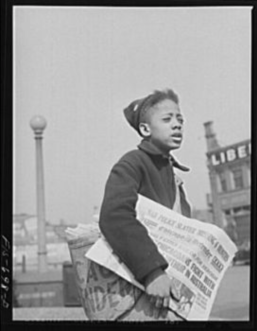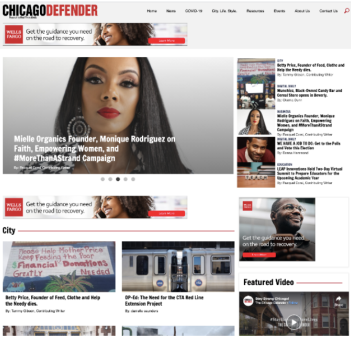
Defending the Digital Transition
Sept. 10, 2020
A little over a year ago, the Chicago Defender made the decision to transition from print to completely online.
Did it work? What lessons have been learned? I recently talked with Hiram Jackson, the CEO of the Defender’s parent company, Real Times Media, to find out.
For those not familiar with the Defender, it has a long, important history in journalism in this country. It was founded in 1905 and was considered the nation’s most influential Black weekly newspaper.

Selling the Chicago Defender on the street in 1942. (Photo credit: Farm Security Administration - Office of War Information photograph collection; Library of Congress)
In the 1950s it transitioned to a daily paper, making it the largest Black-owned daily in the world, according to PBS. Eventually the Defender added several more papers to its portfolio, which now includes the Atlanta Daily World, Atlanta Tribune, Michigan Chronicle and the New Pittsburgh Courier.
It eventually returned to its roots of being a weekly product in print, but now is all digital, all the time.
The transition hasn’t been easy, but Jackson believes it is the best thing for the future of the Defender, and eventually the rest of Real Times Media’s publications.
“It was really difficult in terms of which one would we do this with,” Jackson said. “I had a real deep desire to go all digital with one of them. … I felt like it was inevitable. I still feel like it is inevitable that at some point the paper business model just doesn’t work like it used to.”
Jackson said the Defender was chosen because that brand had very strong name recognition.

Of course, any time there is change, especially significant change, there is going to be pushback. The Defender’s move to digital was no exception. Jackson said the publication’s younger audience applauded the move, but baby boomers, in particular, didn’t take kindly to it. The nostalgia factor certainly played a role in that.
“We had a lot of people who were really disappointed,” Jackson said. “They walked to the corner store and got their Defender and remember their mom or grandma had the Defender. It was such an important newspaper, and there is a certain level of fondness you associate the Defender with. It’s not just a newspaper, it’s an emotional attachment.”
At the same time, the audience realized a change might be necessary considering the state of print media. Of course, that narrative often comes with another one — that the publication is struggling financially. Jackson said those two didn’t go hand in hand at the Defender.
“They saw it as the first step to going out of business, quite frankly,” Jackson said. “Maybe we just didn’t message that well. To us, it was a necessary step to ensure that we had a future. We wanted to be proactive about it as opposed to waiting until we got to a point where we were financially impaired and it was a mandatory move.”
There were bumps along the way in the transition to a completely digital offering, including monetizing the site.
“We learned that it is not a matter of just traditional ad sales,” Jackson said, adding that a local community newspaper cannot thrive with a revenue model based on CPMs and tower and banner ads.
“With a local, small community niche organization, it is difficult to drive enough traffic to monetize enough pennies to support a payroll,” he said. “We have to have multiple streams (of revenue), not just monetizing visitors and uniques.”
So how did the Defender do it? The publication was able to make the transition to digital because Jackson felt the brand recognition was strong, but also because it had diversified its revenue sources through events and an integrated marketing agency called RTM360.
“We carved out our niche where clients come to us to create a unique avenue to engage their consumers,” he said.
The events space, like everything else, has changed this year due to COVID-19, and the Defender has had to adjust. Jackson said they usually do about 65 events each year. The recently completed Men of Excellence event is an example of that. Normally that would be an in-person event for 600-800 people in Downtown Chicago. But this year the event was streamed on Facebook, and had thousands of views, Jackson said.
Continued adjustments will need to be made going forward, as the entire media industry continues to change along with technology, the economy and the world at large.
“We have to continue to evolve,” Jackson said. “The business continues to change. The challenge is reaching the 18- to 30-year-olds. That continues to be a challenge for us.”
Instead of reaching them through the Defender in print or online, they’ve developed sub-brands and programs to target them.
“I may not be able to get that 25-year-old with the (New) Pittsburgh Courier," Jackson said, "but I can get them with the development of programs in that community.”
Those things include the Fab 40 in Pittsburgh, The Front Page in Detroit, and outreach to young professionals in Atlanta.
“They may not have same appreciation for the history and reverence of the Courier or Defender," Jackson said, "but we have been really effective at creating programs for them and highlight the people they are following.”
Jackson said when protests started across the country, the Defender’s traffic increased significantly, as it did when COVID-19 first hit the U.S.
He said the evolution of the Defender won’t stop at just going digital, and that the speed of change this year has been productive. He’s also learned a lot about his own publication and how the community views it.
“We don’t do sensationalized news. When people see our name on it they assume it is true and trust it,” Jackson said. “We were always hopeful that people would accept the transition. Now we know that people want our content and need our content and they still feel like they’re not getting enough of it."
“I think the future is pretty bright."
